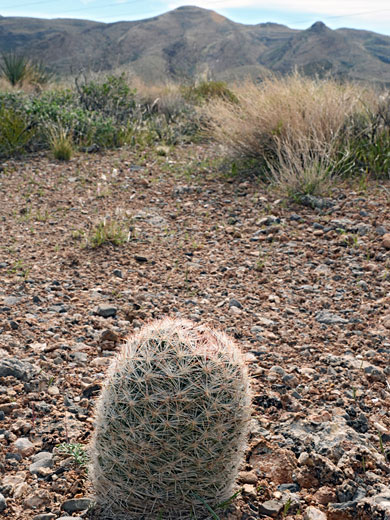Scientific name:
Escobaria chlorantha, coryphantha chlorantha, escobaria vivipara var deserti
Common name:
Desert pincushion cactus
Range:
The Mojave Desert; Utah, California and Nevada
Form:
Small globes or cylinders; usually unbranched
Habitat:
Desert flats and slopes, often on limestone or dolomitic soils
Flowers:
Orange, creamy yellow or pale brown. Blooms April to June

Distribution map for escobaria chlorantha
Escobaria chlorantha, or coryphantha chlorantha, is very similar to the much more widespread escobaria vivipara, the main difference being the flowers - the inner tepals of this species are orange, creamy yellow or pale greenish brown (with darker midstripes on the undersurfaces), angled upwards and/or slightly recurved at the tips - generally not opening fully, while those of the latter species are pink or purple, spreading, and more strongly recurved.
Outer tepals of escobaria chlorantha are fringed. Stamens have white or pale pink filaments and orange-yellow anthers, while stigma lobes (up to 11 of them) are pale greenish-white. Fruits are pale green capsules, around 1 inch long, and they retain the withered flower throughout the summer, unlike some similar species for which the floral remnants are early-deciduous.
Stems are globes or short, relatively thick cylinders; up to 6 inches tall and 4 inches across, and not partially buried in the soil, as with some other escobaria species. There are between 18 and 41 spines per areole, often completely obscuring the stem; from 12 to 33 radial spines, gray or pinkish, and up to 13 central spines (inner and outer), the longest 0.8 inches. All spines are darker at the tip.
Plants inhabit desert scrub, associated with blackbrush, creosote bush and pinjon-juniper trees, between 1,300 and 5,500 feet elevation, occasionally up to 7,500 feet.
Outer tepals of escobaria chlorantha are fringed. Stamens have white or pale pink filaments and orange-yellow anthers, while stigma lobes (up to 11 of them) are pale greenish-white. Fruits are pale green capsules, around 1 inch long, and they retain the withered flower throughout the summer, unlike some similar species for which the floral remnants are early-deciduous.
Stems are globes or short, relatively thick cylinders; up to 6 inches tall and 4 inches across, and not partially buried in the soil, as with some other escobaria species. There are between 18 and 41 spines per areole, often completely obscuring the stem; from 12 to 33 radial spines, gray or pinkish, and up to 13 central spines (inner and outer), the longest 0.8 inches. All spines are darker at the tip.
Plants inhabit desert scrub, associated with blackbrush, creosote bush and pinjon-juniper trees, between 1,300 and 5,500 feet elevation, occasionally up to 7,500 feet.
All Contents © Copyright The American Southwest | Comments and Questions | Contribute | Affiliate Marketing Disclosure | Site Map


